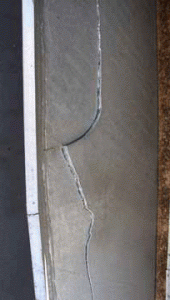Hydrogen & Strain-Age Embrittlement
Although it happens infrequently, embrittlement of steel during the hot-dip galvanizing process is possible. If a steel member embrittles during galvanizing, odds are it is due to strain-age embrittlement and not hydrogen embrittlement or liquid-metal embrittlement. To greatly reduce or eliminate the potential for embrittlement of steel hot-dip galvanized after fabrication, refer to the practices and procedures defined within ASTM A143, Standard Practice for Safeguarding Against Embrittlement of Hot-Dip Galvanized Structural Steel Products.

Excessive cold-working of steel prior to galvanizing is the key factor for strain-age embrittlement to develop and the heat in the galvanizing process simply accelerates the recognition of embrittlement. Maximizing bend radii and performing a thermal/heat treatment of cold-worked articles prior to galvanizing effectively minimize the potential for strain-age embrittlement. Stain-age embrittlement can be observed immediately after galvanizing, as opposed to hydrogen embrittlement which is not observed until the part is under load for an extended period of time.
Hydrogen embrittlement is very rare during the galvanizing process, and typically only of concern for steels with an ultimate tensile strength greater than 150 ksi due to a tight grain structure trapping hydrogen molecules readily available from the chemical cleaning acid used in the galvanizing process. Performing mechanical cleaning instead of acid chemical cleaning, or heating after chemical cleaning to expel entrapped hydrogen, are effective means of guarding against hydrogen embrittlement for steels >150 ksi.
Liquid-metal embrittlement (LME) is the result of liquid metal which is able to contact a solid metal and initiate cracking under certain conditions (mainly temperature). It is well known that zinc cannot cause the embrittlement of steel due to the fact that people have been galvanizing steel for nearly 150 years. However, other types of metal may be susceptible to this type of embrittlement, but often require much higher temperatures than experienced in hot-dip galvanizing. As a result, this type of embrittlement is not of concern during the hot-dip galvanizing process.
Case Study: Hydrogen Embrittlement
The Oakland Bay Bridge; Oakland CA, 2013

The San Francisco Oakland Bay Bridge (SFOBB) is connected to Pier E2 at the east side by means of 96, 3‐inch diameter, galvanized ASTM A354 Grade BD (A354BD) anchor rods fabricated and installed inside the Pier E2 concrete bent cap in 2008 (2008 Rods). In early March 2013, after erection of the superstructure and load transfer was completed, the rods were pre‐tensioned to 70% of their minimum specified ultimate tensile strength. A few days after tensioning was completed, 32 of the 96 anchor rods fractured. All 32 fractures occurred at or near the threaded engagements at the bottom ends of the rods. Failure of the rods ceased after the pre-tension level in the remaining rods was reduced. All of these 96 rods were abandoned and an alternative anchoring system was successfully designed and installed. Although the 2008 rods are no longer in service, their failure raised concerns about the long-term performance of the remaining A354BD rods on the bridge.
A testing program organized by the California DOT found that the 2008 rods failed as a result of environmentally-induced hydrogen embrittlement and it is not likely hydrogen was introduced by the galvanizing process to cause hydrogen embrittlement. It was also determined that there was a decrease in the hydrogen embrittlement threshold of these rods that contributed to the failures. Additionally, there was an issue with the heat treatment of one particular batch of rods which is likely the root cause for the decreased hydrogen embrittlement threshold of the affected bolts.
Overall, the results of the study indicate the rods on the bridge failed by environmentally induced hydrogen embrittlement because they were tensioned above their hydrogen embrittlement threshold while simultaneously immersed in water, which served as the source of hydrogen. The low hydrogen embrittlement threshold of the 2008 rods is likely due to rod fabrication methods, not galvanizing.